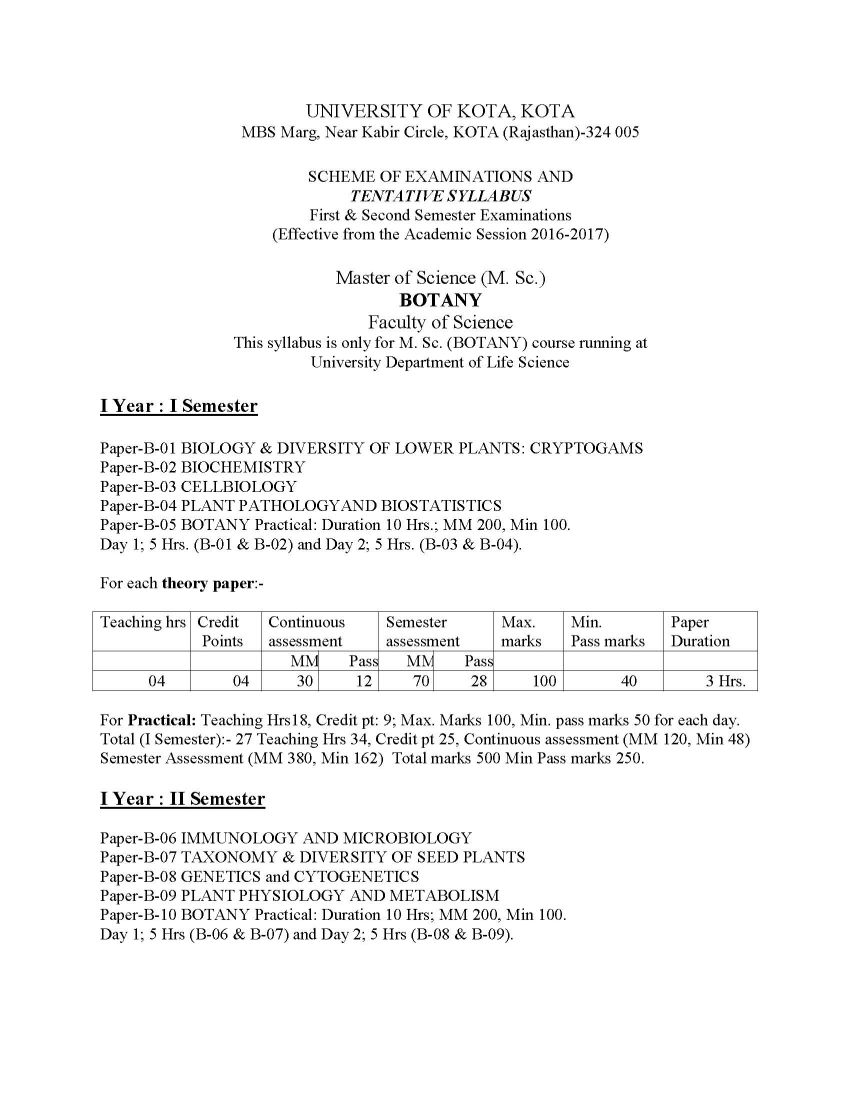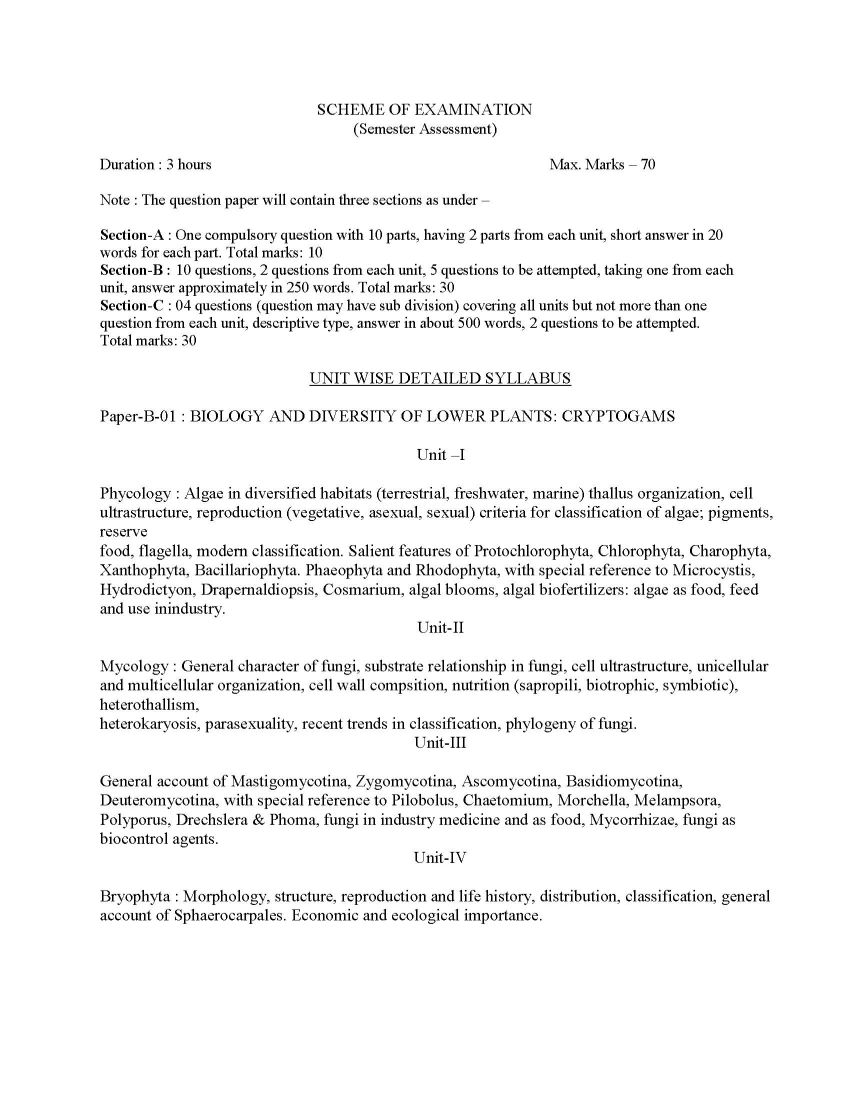|
#3
18th April 2018, 06:59 AM
| |||
| |||
| Re: M.Sc Botany Syllabus Kota University
I am providing you the syllabus of M.Sc Botany program of University Of Kota, Kota University Of Kota M.Sc Botany syllabus I Year : I Semester Paper-B-01 BIOLOGY & DIVERSITY OF LOWER PLANTS: CRYPTOGAMS Paper-B-02 BIOCHEMISTRY Paper-B-03 CELLBIOLOGY Paper-B-04 PLANT PATHOLOGYAND BIOSTATISTICS Paper-B-05 BOTANY Practical: Duration 10 Hrs.; MM 200, Min 100. Day 1; 5 Hrs. (B-01 & B-02) and Day 2; 5 Hrs. (B-03 & B-04). I Year : II Semester Paper-B-06 IMMUNOLOGY AND MICROBIOLOGY Paper-B-07 TAXONOMY & DIVERSITY OF SEED PLANTS Paper-B-08 GENETICS and CYTOGENETICS Paper-B-09 PLANT PHYSIOLOGY AND METABOLISM Paper-B-10 BOTANY Practical: Duration 10 Hrs; MM 200, Min 100. Day 1; 5 Hrs (B-06 & B-07) and Day 2; 5 Hrs (B-08 & B-09) Paper-B-01 : BIOLOGY AND DIVERSITY OF LOWER PLANTS: CRYPTOGAMS Unit I Phycology : Algae in diversified habitats (terrestrial, freshwater, marine) thallus organization, cell ultrastructure, reproduction (vegetative, asexual, sexual) criteria for classification of algae; pigments, reserve food, flagella, modern classification. Salient features of Protochlorophyta, Chlorophyta, Charophyta, Xanthophyta, Bacillariophyta. Phaeophyta and Rhodophyta, with special reference to Microcystis, Hydrodictyon, Drapernaldiopsis, Cosmarium, algal blooms, algal biofertilizers: algae as food, feed and use inindustry. Unit-II Mycology : General character of fungi, substrate relationship in fungi, cell ultrastructure, unicellular and multicellular organization, cell wall compsition, nutrition (sapropili, biotrophic, symbiotic), heterothallism, heterokaryosis, parasexuality, recent trends in classification, phylogeny of fungi. Unit-III General account of Mastigomycotina, Zygomycotina, Ascomycotina, Basidiomycotina, Deuteromycotina, with special reference to Pilobolus, Chaetomium, Morchella, Melampsora, Polyporus, Drechslera & Phoma, fungi in industry medicine and as food, Mycorrhizae, fungi as biocontrol agents. Unit-IV Bryophyta : Morphology, structure, reproduction and life history, distribution, classification, general account of Sphaerocarpales. Economic and ecological importance. Unit-V Pteriodophyta : Morphology, anatomy and reproduction, classification; evolution of stele; heterospory and origin of seed habit; general account of fossil pteriodophyta; introduction to Psilplosida, Lycopsida, Sphenopsida and Pteropsida; with special reference to Lycopodium, Gleichenia, Pteris, Isoetes & Ophioglossum. Paper-B-02 : BIOCHEMISTRY UNIT I 1. Introduction: Basic chemical concepts: a study of the chemical bonds and functional groups. 2. Biocatalysts : Classification and nomenclature of the enzymes; nature of enzymes, enzyme specificity; factors affecting enzyme activity; enzymatic and non-enzymatic catalysts; coenzymes and their functions. Enzymes and prosthetic groups. 3. Energy considerations: Biological oxidation & reduction. Fundamental reactions of biological oxidation; redox potential and electron transport system. UNIT II 1. Carbohydrate Classification, structure, general properties and functions of polysaccharides and complex carbohydrates; amino sugars, proteoglycans and glycoproteins. 2. Lipids Classification, structure, properties and functions of fatty acids, essential fatty acids, fats, phospholipids, sphingolipids, cerebrocides, steroids, bile acids, prostaglandins, lipoamino acids, lipoproteins, proteolipids, phosphatidopeptides, lipopolysaccharides. 3. Nucleic acids Classification, structure, properties and functions of nucleic acids. Primary, secondary and tertiary structure of nucleic acids, DNA forms and conformations, Denaturation of DNA. UNIT III 1. Proteins Peptide synthesis: chemical and Merrifield synthesis. Primary (peptide conformation, N- and C- terminal, peptide cleavage), Secondary (α-helix, sheet, random coil, Ramachandran plot), Tertiary and Quaternary structures of proteins. 2. Vitamins Classification, structure, properties and functions of vitamins. 3. Hormones Classification, structure, properties and functions of Hormones. UNIT IV 1. Metabolic pathways of protein (General reactions of amino acid metabolism -Transamination, decarboxylation, oxidative & non-oxidative deamination of amino acids.) 2. Metabolic pathways of carbohydrates (Glycolysis, various forms of fermentations in microorganisms, citric acid cycle, its function in energy generation and biosynthesis of energy rich bond, pentose phosphate pathway and its regulation. Gluconeogenesis, glycogenesis and glycogenolysis, glyoxylate and Gamma aminobutyrate shunt pathways, Cori cycle, EntnerDoudoroff pathway, glucuronate pathway. Metabolism of disaccharides.) 3. Metabolic pathways of lipids (hydrolysis of tri-acylglycerols, α-, β-, ω- oxidation of fatty acids. Oxidation of odd numbered fatty acids fate of propionate, role of carnitine, degradation University Of Kota M.Sc Botany syllabus     Contact- University Of Kota Swami Vivekananda Nagar, Near Kabir Circle, MBS Marg, Swami Vivekananda Nagar, Kota, Rajasthan 324 005 For complete syllabus here is the attachment |